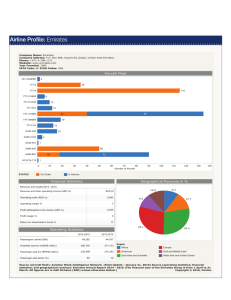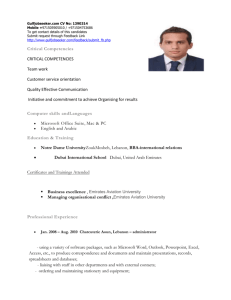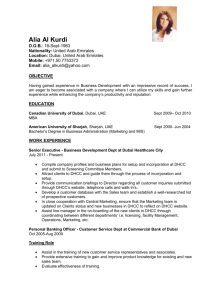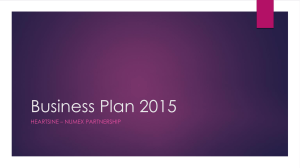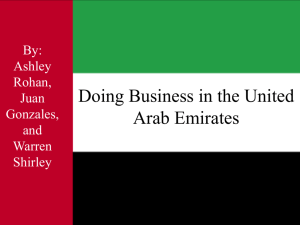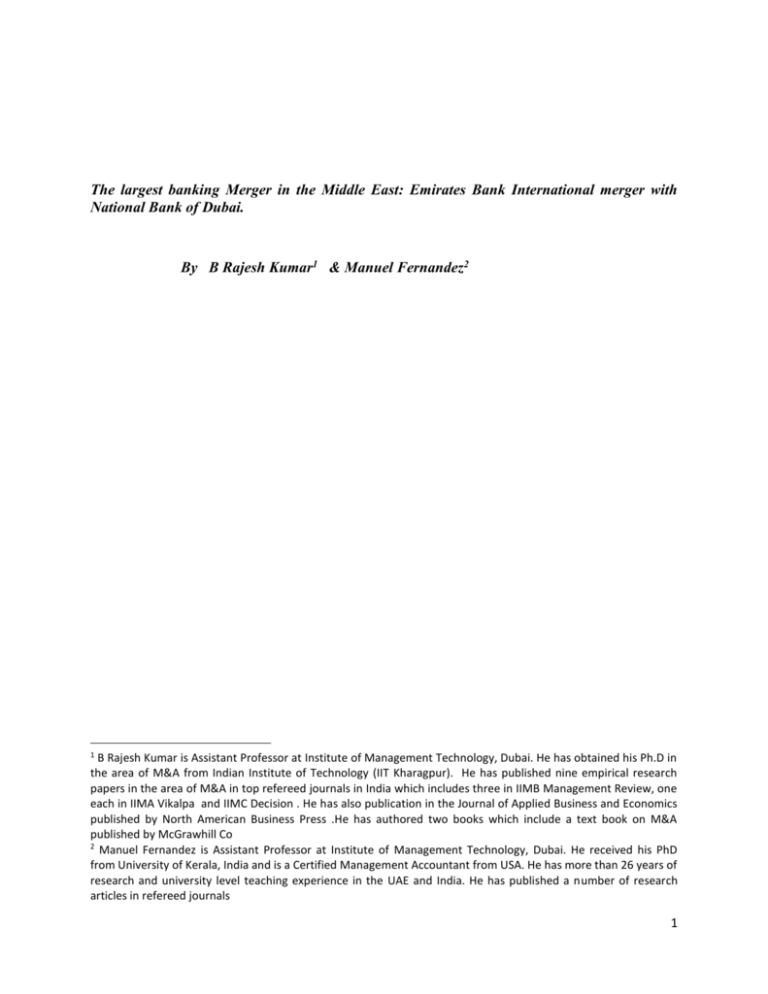
The largest banking Merger in the Middle East: Emirates Bank International merger with
National Bank of Dubai.
By B Rajesh Kumar1 & Manuel Fernandez2
1
B Rajesh Kumar is Assistant Professor at Institute of Management Technology, Dubai. He has obtained his Ph.D in
the area of M&A from Indian Institute of Technology (IIT Kharagpur). He has published nine empirical research
papers in the area of M&A in top refereed journals in India which includes three in IIMB Management Review, one
each in IIMA Vikalpa and IIMC Decision . He has also publication in the Journal of Applied Business and Economics
published by North American Business Press .He has authored two books which include a text book on M&A
published by McGrawhill Co
2
Manuel Fernandez is Assistant Professor at Institute of Management Technology, Dubai. He received his PhD
from University of Kerala, India and is a Certified Management Accountant from USA. He has more than 26 years of
research and university level teaching experience in the UAE and India. He has published a number of research
articles in refereed journals
1
The largest banking Merger in the Middle East: Emirates Bank International merger with
National Bank of Dubai3
“This merger brings together the UAE's second and fourth largest banks by assets. As a combined entity, we believe the
Company will be well positioned to grow and to deliver outstanding value to its shareholders, customers, and employees".
"We are proud to be playing a leading role in the development of Dubai as a regional financial centre, in line with HH Sheikh
Mohammed's 2015 Strategic Plan”
H.E. Ahmed Humaid Al Tayer
Chairman Emirates NBD
Section 1: Highlights of the merger.
Emirates NBD is the biggest banking group in the Middle East in terms of assets. The Group has
a leading retail banking franchise in the UAE with 536 ATMs and 114 SDMs across both
conventional and Islamic banking franchises. It is a major player in the UAE corporate banking
arena with a combined market share of almost a fifth of corporate loans .It has also strong
Islamic banking, investment banking, private banking, asset management and brokerage
operations. The Dubai Government owned around 14 per cent of NBD and about 77 per of
Emirates Bank.
On March 6 2007, the merger between Emirates Bank and National Bank of Dubai to form
“Emirates NBD “was announced. Emirates were the second largest and National Bank of Dubai
was the fourth largest bank in UAE. This merger was in tune with the high levels of growth
achieved by the banking industry over the past few years on the back of the booming UAE and
regional economies. During the past three years, the UAE GDP grew at an average rate of 20 per
cent. In 2007 the total assets of UAE banks grew by 45 per cent to US $ 337 billion. The value of
deposits grew by 35 per cent to US $ 204 billion.
The merger resulted in the union of two powerful legacies which was aimed to become a leading
regional financial institution with an increasing international presence .The merger was aimed to
leverage financial strength, scale and market positioning to capture domestic and regional
opportunities. The merger facilitated the partnership for wholesale, retail, investment, treasury
and Islamic banking clients .The total income of the two banks reached AED 7.1 billion , an
increase of 50 per cent year on year. The group became a major player in the corporate banking
arena with a joint market share of almost a fifth of corporate loans. This strategic merger was
3
The author developed the case for class discussion rather than to illustrate
either effective or ineffective handling of the situation. The case is based
on published secondary data.
The case, instructor’s manual, and synopsis were anonymously peer reviewed
and accepted by the Western Case writers Association Conference, March 25,
2009, Kailu-Kona, Hawaii. All rights are reserved to the author. Contact:
Issam A. Ghazzawi, University of La Verne, College of Business and Public
Management,
1750
Third
Street,
La
Verne,
CA
91750,
909-593-3511,
ighazzawi@laverne.edu.
2
meant to create a bank with scale, financial strength and service quality standards to compete
effectively in a dynamic market.
Significance of the merger
Increased Power
The merger created a national champion and a regional powerhouse
Largest UAE bank by assets and market capitalization
Significant strengthening of competitive positioning
Highly diversified business mix
Corporate/retail banking powerhouse
Significantly enhanced distribution network in the UAE
Increased Financial Strength and Scale
Largest bank by assets in the GCC
Among top five regional bank by market capitalization
Well capitalized with the highest shareholders’ equity in the UAE on a combined basis.
Expanded regional presence
Strategically positioned to capture high growth potential of domestic and regional
markets
Superior Value creation potential
Expected significant cost and revenue synergies driving value creation
Significant Events
Date
06 March 2007
Events
The merger between Emirates Bank and National Bank of Dubai was
announced
14 March 2007
A Merger steering committee was appointed
09 April 2007
Goldman Sachs International appointed as lead financial advisors on the
merger
12 July 2007
Emirates Bank and National Bank of Dubai announced terms of their
merger
05 Sept 2007
Emirates Bank Shareholders approved the merger terms at Extraordinary
General meeting
06 Sept 2007
National Bank of Dubai shareholders approved the merger’s terms at an
Extraordinary General Meeting
18 September 2007 Emirates NBD closed its initial offer to shareholders of National Bank of
Dubai and Emirates Bank
08 October 2007
Emirates bank and National Bank of Dubai’s shares were suspended from
3
16 October 2007
18 October 2007
04 Nov 2007
trading on the Dubai Financial market
Trading began on shares in Emirates NBD PJSC , the newly merged
banking group listed on the Dubai Financial market .
Emirates NBD announced the integration of its ATM Network making it
the largest in the UAE.
The National Bank of Dubai’s building became the new headquarters for
Emirates NBD.
Emirates NBD’s strategy is focused on seven key areas.
1) Retail banking
The merger was intended to consolidate the bank’s leadership position in the retail
business. The merger facilitated the creation of a strong brand for the combined retail
business which had the largest distribution network in the UAE.
2) Wealth Management
Wealth management services have been growing strongly in the UAE on account of
sustainable economic growth. Emirates Private banking offers immense potential for
growth. The consolidated bank would be in a position to leverage the bank’s investment
banking, asset management, structured product, real estate, trust and family office
product capabilities in order to further enhance the wealth management business.
3) Corporate banking
The merger was also aimed to boost the combined bank’s leading position in the
corporate banking arena. The rapid growth of small and medium sized enterprises in the
region was meant by Emirates NBD’s sophisticated and tailored product offerings .This
forms a core strategy for the bank to further increase the growing corporate and
institutional client base.
4) Investment Banking
Dubai’s emergence as a financial centre has facilitated Emirates NBD’s attempt to create
a world class investment banking platform. The merger also intended to enhance the
product capabilities that ranged from corporate finance advisory and execution to private
equity offering.
5) Islamic Banking
Emirates NBD also envisages enhancing and expanding Islamic banking. The strategic
perspective involved expanding the current branch network and increasing innovation in
the Shariah compliant product portfolios .Expansion was also possible from cross selling
to the Bank’s broader customer base.
6) Strategic Expansion
The merger aimed to strength the bank’s presence in the GCC particularly in the
Kingdom of Saudi Arabia and Qatar. The merged bank could leverage the scale, financial
strength and existing regional network to pursue this strategic objective.
7) IT and operations
4
The synergistic benefits would also result from the integration of the two banks
Information systems and operations which could result in value addition through
reduction in costs.
Financial Highlights
The significance of the merger of Emirates Bank International (EBI) and National Bank
of Dubai (NBD) was reflected in the strong pro forma results of Emirates NBD. Total
income reached AED 7.1 billion on a proforma basis .The primary drivers for the
increase in total income were robust growth in customer assets supported by a rise in
customer deposits across both the retail and wholesale businesses .The group continued
to maintain a healthy mix of funded and non funded income. The growth in income was
supported by a steady increase in fee based product revenue.
The operating costs for Emirates NBD was AED 2.7 billion on a pro forma basis, an
increase of 51 per cent over 2006. The increase in costs was driven by continued
investments in expanding distribution and product capabilities building robust
infrastructure and developing strong governance capabilities.
Net profits of the Group were AED 4 billion (excluding amortization of intangibles) for
2007 on a pro forma basis, an increase of 35 per over 2006. Emirates NBD reported a
25.12% return on average shareholder equity, a 1.6% increase in 2006. Total assets
recorded at the end of 2007 were AED 253.8 billion an increase of 53% for EBI and
NBD’s combined assets in 2006.This positioned Emirates NBD with a 20.5 per cent
market share of banking assets in the UAE and as the largest bank in the Middle East.
Business Highlights
Emirates NBD’s wholesale banking’s net income (excluding IPO business) grew by 38
per cent and its assets by 42 per cent in the year 2007.The Structured Finance and
Syndication Division (SFS) remained at the forefront of the UAE’s loan syndication
market in 2007.The division gained a significant share in the local debt syndication
market in value and number of deals acting as mandated lead arrangers and book runners
in a number of high profile transactions. The division also led managed multiple
benchmark transactions for the UAE’s largest and highest profile issuers in the year 2007.
The Financial Institutions Division (FDI) became an important contributor to the
wholesale banking sector in the year 2007. In 2007, the division managed an array of
products and services ranging from debt syndications, forfeiting trade and payment tie
ups, structured credit, primary and secondary trade financing and asset distribution from
its revenue contribution.
Consumer Banking and Wealth Management
As a result of the merger, the Group’s distribution network became the largest in the
UAE in 2007.Emirates NBD ended the year with a total of 88 retail branches following
the opening of 13 new outlets .The number of ATMs increased to 440 following the
5
implementation of an additional 88 in the period .The expansion of the Al Shaheen and
Suhail branch network to 27 in 2007 positioned the Bank with the largest network of
affluent banking centres in the country. Growth in customer deposits and loans was
strong in 2007 outperforming the market growth. With the advent of cross selling across
the integrated group, improved delivery across all channels and a partnership with the
UK’s John Charcoal Brokers facilitated NBD to become the UAE’s leading non Islamic
home loans provider in 2007.These additional advantages increased the importance of the
mortgage business for the bank.
In April 2007, ahead of the Emirates Bank and NBD merger, the asset management
business of EBI merged with the asset management business of Emirates Financial
Services to form Emirates Investment Services (EIS).
Private Banking
As part of its expansion strategy , Emirates NBD acquired two new locations in 2007
.The Private Banking division worked with its London Office for the introduction of the
Hammersmith project to its client base .The Investment Management Group added a mix
of mutual funds to its platform in 2007 covering emerging markets, multi manager ,
global real estate and commodities .
Investment Banking
NBD Investment Bank provides integrated investment banking, financial markets and
private equity solutions and serves the needs of corporations, governments, institutional
and high net worth clients across the GCC and wider MENATSA region. A number of
transactions were successfully managed by the investment bank on behalf of prestigious
clients such as Nakheel, Dubai Aerospace, Istithmar, Dubai World Trade Centre and
GEMS (loan syndication and bridge finance)
Group Treasury and Markets
In 2007 , the group treasury activities included USD 1.5 billion 5 year syndicated deposit
facility ; USD 1 billion Sukuk –Trust Certificate Issuance program arranged for Emirates
Islamic bank. The Group’s new credit structuring and trading areas became fully
operational in 2007 .The Foreign Exchange and Interest rate trading volumes increased
positioning the newly merged group as a leading market maker in GCC currencies.
As a result of the merger, the Group’s direct International footprint extended to six
countries outside of UAE namely the kingdom of Saudi Arabia, Qatar, United Kingdom,
India, Iran and Singapore. The international banking team participated in four merger and
acquisition transactions successfully acquiring a card services company in Egypt, a
strategic move for the Group’s North Africa development plans.
Information Technology and Operations
A number of major system initiatives were implemented in the year 2007 including core
banking system replacement, the adaptation of an ERP system for e HR and Enterprise
Financial Management and the implementation of a state of the art treasury system
6
which enables integrated processing of the front, middle and back offices. A new
consumer finance system that processes the complete life cycle of loans was implemented
in the year 2007.
According to bank officials, merger synergies achieved in the year 2008 exceeded the
initial expectations in the year 2008 with total synergies achieved during 2008 of AED
235 million exceeding the targeted synergies of AED 124 million by 90% .
The integration of the combined banks Group ATM’s and Smart Deposit Machines
(SDM) were completed by 2008 which rose to more than 650 across UAE making it the
biggest network in the country. Mobile and online banking has also been fully integrated
with enhanced functionalities and 13 payment partners available to all of the bank’s
customers.
The Key terms of the merger
The creation of Emirates NBD was by the merger of common ownership of EBI and
NBD. The salient features of the consideration were 1) Exchange ratio of 0.95 Emirates
NBD shares for every NBD share. 2) Exchange ratio of 1 Emirates NBD for every EBI
share.
As on July 01 2007, the implied share price for NBD was AED 8.84.The implied share
price for EBI was AED 9.30.The implied total consideration was AED 13.75 billion.4The
offer price represented 14 per cent premium to the prices on the day prior to
announcement. The exchange ratio of 0.95 EBI share for 1 NBD share implied that EBI
shareholders owned 66.3 per cent of the share capital in Emirates NBD and NBD
shareholders owned 33.7 per cent of share capital in Emirates NBD.
Key Merger benefits
Shareholders
Creation of the leading UAE banking Franchise
Enhanced regional and international expansion opportunities
Increased financial strength and capital position to support growth
Value creation through revenue and cost synergies established management
expertise and exchange of best practices
Customers
Greater Convenience through broader domestic branch and ATM Networks
Wider access to regional and international markets through the Group’s expanded
presence
Broader product suite and delivery of more customized financial solutions
Employees
4
Share price of EBI of AED 10.48 on 5 March 2007 , implying a share price for NBD of AED 9.96 based on 0.95x
exchange ratio .Market price of NBD on 5March 2007 of AED 8.75 implying 14% premium. All share prices
adjusted for bonus share issues.
7
Enhanced career opportunities through a growing and more diversified organization
Improved training and career development capacity
Greater ability to attract and retain top talent
Synergies expected from the Merger
Revenue synergies
Corporate banking-The cross selling of major product capabilities is expected to result in
revenue synergy through increase in fee income.
Retail banking – In this sector, the focus will be on cross selling among major product
categories. Revenue synergy is also expected from incremental revenue generated through
market share/pricing advantages and leveraging of the largest distribution network in UAE.
Investment banking – Expansion of client base and cross selling of new product capabilities is
expected to lead to revenue synergies .Greater penetration is also expected particularly regionally
in larger projects and financing deals by leveraging balance sheet and capital .
Revenue synergy is also expected from improved cost of funding due to a stronger capital base
and improved sales due to integrated broader offering.
Cost Synergies
Cost synergies is expected to result from retail banking due to a) Branch and ATM network
consolidation b) Integration of card acquiring business c) Pricing advantages on advertising
/marketing spend. The cost synergy was also expected from Optimized head office and group
functions .Cost synergies would also result from reallocation of IT personnel from NBD to EBI
IT dedicated centre. Cost synergies were also expected from brokerage due to improved
efficiency from integrated operations and IT platform. Cost synergies are also expected from
leveraging Emirates Islamic bank as a platform for unified Islamic offerings.
In 2008, full year synergy targets were exceeded on all revenue, costs and one off synergies with
achieved synergies AED 235 million ahead of target by 90 per cent .
Target Synergies : AED 346 million of recurring annual synergies were expected by the third
year post merger ,plus AED 26 million of one off synergies totaling AED 372 million .The
recurring synergies as given below was expected to be delivered 33 per cent in year 1 (2008),
66% in year 2 (2009) and fully by 2010.
Synergies Total AED % of Smaller base
% of combined base
(2010)
million
Actual Benchmark***
Actual
8
Revenue
195
10.5%
5-10%
4.1%
Costs
151
22.2%
14-26%
8.3%
Source: Emirates NBD Merger Report
Year 1 target therefore AED 12 million (33% of AED 372 million) of which recurring synergies
represent ;( one off synergy commitment in 2008 is AED 9 million)
Synergies Total AED % of Smaller base
% of combined base
(2008)
m
Actual Benchmark***
Actual
Revenue
65
3.5%
1.7-3.3%
4.1%
Costs
50
7.4%
4.6-8.6%
2.7%
Note: Base used was 2006 financial parameters for computing synergy targets .Smaller base was
NBD and combined was aggregated EBI and NBD .
It is reported that the achieved synergies were to a tune of AED 235 million –ahead of 2008 full
year target by 90 per cent.
Key drivers of Revenue synergies
Revenue Synergies for 2008 full year (AED 104 m) resulted on account of:
Largest distribution network of 120 branches and 659 ATMs and SDMs.
Focus on cross selling like mortgages greater than AED 100 m loans
Enhanced market share/ pricing advantages.
Embedded customer efficiency framework which was reflected in tripling of branch sales
Key drivers of Cost synergies
Cost Synergies:2008 (AED 109 million)
Single Head office in place
Created efficiencies through unified business models
Combined marketing and advertising efficiencies
One off Synergies for 2008 full year (AED 22 m) –On account of projects and initiatives
discontinued due to merger namely Islamic banking set up previously planned in NBD.
Governance
The board was evenly split with six members from EBI and six from NBD .There were 12 non
executive positions.
Integration Process.
9
Emirates NBD was listed on Dubai Stock Exchange on 16th October 2007.The first Annual
General meeting for Emirates NBD took place on 23rdth March 2007. By April 2008, the
combined bank was able to successfully integrate 92 smart deposit machines .By July 2008 , the
integration of ATMs was completed to form the largest network in the UAE which consisted of
545 ATMs. Emirates NBD’s large corporate unit was inaugurated by July 2008.During the
period Aug –Dec 2008 integration of other systems took place. Treasury teams started
functioning as a single foreign exchange trading entity. Mobile and online banking were
integrated with enhanced functionalities. The integration of credit cards platform was completed
by Feb 2009.
The entire integration process was fully on tract for completion by 2009 .The major milestones in
the system integration like retail loan systems on FinnOne, the General ledger on Oracle and the
integration of the call centre platforms were completed in 2009. The final milestone of the
migration of NBD customers on to the new core banking system, Finacle were planned for
November 2009. The integration process with respect to legal aspects were expected to be
completed by the final quarter of 2009.
The Current Scenario
The strategic priorities for the combined Emirates NBD would be to navigate the current
environment and take advantage of the opportunities. During the 9 month period ended 30th
September 2009, the total income grew up by 24 per cent compared to AED 6.7 billion for the
same period in 2008. During this period the credit quality remained healthy across the bank’s
corporate and retail portfolios .The total income for the first 9 months of 2009 rose by 24 per
cent to AED 8278 million compared to AED 6664 million in the comparable period of 2008.In
the third quarter of 2009, total income grew by 39% to AED 2768 million from AED 1985
million in Q3 2008. The NPL ratio, excluding impaired investment securities, increased to 1.88%
in Q3 2009 from 1.56% reported in Q2 2009 and 0.95% reported in 2008.
Emirates NBD’s branch network grew further in the 9 months ended 30 September 2009, with
the addition of 5 new branches, taking the total to 99. Wholesale banking deposits increased by
23 per cent since 31 December 2008 and the advances portfolio increased by 9 per cent since the
end of 2008.The merged bank have now a combined market share of almost a fifth of corporate
assets in the UAE
The largest banking merger of the Middle East is expected to be completed this year on target
and with synergies ahead of forecast .In the context of recessionary trends across the world,
Emirates NBD has to pursue its growth opportunities to realize the synergistic benefits from the
merger.
10
Appendix
Financial Parameters: Emirates Bank
Parameter(AED in 2005
000)
Total Assets
59412867
Total Liabilities
51662648
Loans and
38567246
Receivables
Customer deposits 29464340
Total operating
2240901
Income
Net Profit
1728581
Financial Parameters: NBD
2006
Parameter(AED in
000)
Total Assets
Total Liabilities
Loans and
Receivables
Customer deposits
Total operating
Income
Net Profit
2005
2006
51408311
45910627
27936688
69276170
63232535
43218217
37091537
1641009
45408116
1861416
1102795
1106347
95878141
87000094
59278208
40887052
2896209
1888292
Financial Parameters: Emirates NBD Consolidated data for premerger and post merger period
Value in '000 AED
Parameters
Total Assets
Year
2005
110821178
Total Liabilities
97573275
Loans and Advances
66503934
Customer deposits
2006
2007
165154311 253815643
150232629 228656889
2008
282413676
256651755
188006789
66555877
102496425 151952233
86295168 126134743
Total Operating Income
3881910
4757625
4959337
8446716
Net Profit
2831376
2994639
2770908
3681233
139979804
11
Table: 1 NBD Share price daily returns during the announcement period:
Day t Return in %
Cumulative Return in %
-5
0
0
-4
0.975
0.975
-3
1.44
2.415
-2
-1.9
0.515
-1
1.94
2.455
0
0.47
2.925
1
4.73
7.655
2
0.45
8.105
3
-5.8
2.305
4
-0.47
1.835
5
1.92
3.755
Figure: 1 Share Price returns for NBD during the merger announcement period (-40 to + 40 day )
Cumulative share price returns -NBD
0.25
0.2
0.15
0.1
Cumulative share price
returns -NBD
0.05
0
-40 -36 -32 -28 -24 -20 -16 -12 -8 -4 0 4 8 12 16 20 24 28 32 36 40
-0.05
12
Table: 3 Emirates Bank‘s Share price daily returns during the announcement period:
Day t Return in %
Cumulative Return in %
-5
-2.86
-2.86
-4
-2.95
-5.81
-3
-0.38
-6.19
-2
4.19
-2
-1
-4.02
-6.02
0
-3.05
-9.07
1
7.48
-1.59
2
-3.60
-5.19
3
-1.14
-6.33
4
-1.92
-8.25
5
1.96
-6.29
Figure: 2 Share Price returns for EBI during the merger announcement period (-40 to + 40 day)
Cumulative share price returns for
EBI
0.3
0.2
0.1
0
-0.1
-40-34-28-22-16-10 -4 2 8 14 20 26 32 38
Cumulative share price
returns for EBI
-0.2
-0.3
-0.4
13
References
1) www.ebindmerger.com
2) http://emiratesnbd.com/newsroom/article.cfm?newsID=308
3) Emirates NBD Annual Report 2007,
14

